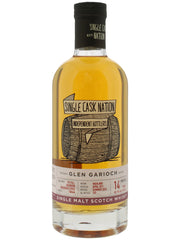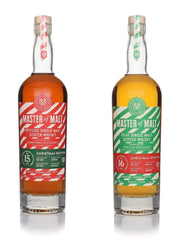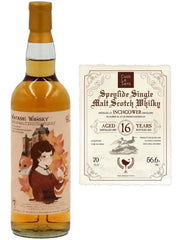
Ok, next up we answer the question: Is Laphroaig cask strength 10 year old better than the core range 10 year old? Read on for our reviews of both and to discover which you should spend your hard earned money on.
But first a little background for those who are interested.
Laphroaig distillery was founded in 1815 by Donald and Alexander Johnston. It remained in the family until Ian Hunter, nephew of Sandy Johnston, passed away in 1954.
Quick aside, Ian is responsible for one of our favourite Laphroaig stories. Ian being the canny Scotsman that he was managed to persuade US customs and excise that Laphroaig had medicinal properties. The logic here being that no one who has ever nosed a dram of laphroaig could argue it’s anything but medicine. This shrewd marketing allowed the distillery to sell its product in pharmacies in the states during prohibition.
Anyway we digress, the distillery passed from Ian to Bessie Williamson. Bessie for those unaware started as typist at the distillery, before working her way up to office manager. This was a pit stop on her way to taking over as the distillery manager. This makes her the first woman to manage a Scotch whisky distillery. On top of that distinction she also ensured that the distillery equipment and stock survived its mothballing during the World War 2. Bessie eventually passed ownership of the distillery to Long John International in 1967. The distillery bounced about between private owners until It ended up in the hands of its current owners Beam Suntory. Beam incidentally own Bowmore distillery among their vast holdings of distilleries.
Anyway enough history onto this whisky:
Laphroaig 10yo Cask Strength Batch 13
Region: Islay
ABV: 57.9%
Price: £72
This is the 13th release of the Laphroaig 10yo cask strength batches. These are matured in ex-bourbon barrels, non chill filtered and bottled at cask strength. We wouldn’t normally mention colour as we don’t think it’s relevant to quality, but after making notes on several similar Laphroaig’s recently we can’t help but notice this looks very dark compared to similarly aged bottlings we’ve drank recently. Our gut tells us there may have been a liberal splash of E150a mixed in with the whisky.
Nose
Good start here, we’re getting butter cream icing, costal sea air, s’mores, smokey bbq sauce and creme brûlée.
Palate
Barbecue beef, brown sugar, medium roast arabian coffee, sea salt, chilli spice, and tobacco. The finish here is long with the above notes fading into the background to leave a spicy peppery finish.
Nose (with water)
Water opens up the nose with the medicinal notes being pushed into the background. The trade off is we’re treated to notes of toffee, cream soda, cotton candy and cloves.
Palate (with water)
This has highlighted the smokier notes. We’re getting burnt brisket, charred vanilla marshmallows, spicy chilli and cinnamon.
Conclusion
It’s good, and we’d happily have another dram or two, but it’s a touch pricey and there’s just something missing here. These missing notes mean it falls slightly short of the quality of the previous cask strength releases or similarly aged independent bottlers offerings.
Laphroaig 10
Region: Islay
ABV: 40%
Price: £39.95
Ok, on to the standard 10 year old. Not a huge amount of detail on this one online, but it’s a safe assumption this is a bourbon cask matured malt. Last time we tried this it was 43% and a cracking dram. Hopefully the reduction in ABV won’t negatively impact the dram.
Nose
The peat is there, but for lack of a better word is very dry. Nose here is a little subdued for a Laphroaig. There’s some sweeter notes here as well, sugarcane, vanilla pasties, and salted caramel sauce. With a little patience you’ll get chimney smoke and costal sea air.
Palate
Palate opens with a dirty bandaid, iodine and tar. Close your eyes and you’ll get wood fire smoke with grilled BBQ meats dripping fat onto the flames. There’s also also some sugar coated cookies, an earthy mineral note, and finally some toasted black peppercorns. The finish here is long with the peat coating your mouth.
Nose (with water)
With water we’re finding a strong rubber note. The sweeter notes like cookies become more pronounced on the palate. Sticking with it, we’re getting toffee, fudge, and honey. The typical Laphroaig notes like iodine have faded slightly.
Palate (with water)
The palate on this benefits from a drop of water with bonfire cinders, bitter oak, dark chocolate and coffee joining the notes above. Quite oily and mouth coating even at the reduced ABV.
Conclusion
This is exactly what everyone describes when they talk about Laphroaig, and this bottling is great value for the quality presented. A great introductory dram for someone wanting to get into heavily peated Islay whisky.
And the winner is?
So which is better? While we prefer our whisky at cask strength with the option to dilute to taste, we can’t deny the core release edges out the cask strength release in taste, while also being significantly cheaper at RRP. This isn’t even factoring in the frequent sales on the core range 10yo, where you can get it for as low as £28. We have to give the win to the Laphroaig 10 core range.
Laphroaig 10 Cask Strength Batch 13: 7/10
Laphroaig 10: 8/10
- 10 - Perfection. A whisky that we’ll remember forever.
- 9 - Amazing. We’d pay through the nose for a bottle.
- 8 - Great. Pick this up at RRP.
- 7 - Good. Happy to have a dram or two but wouldn’t buy a bottle.
- 6 - Passable. Would accept a dram, but wouldn’t seek it out.
- 5 - Poor. Would drink if it was the only option.
- 4 - Bad. Maybe it can be saved by ginger beer?
- 3 - Awful. It can't be saved by ginger beer.
- 2 - Pour it out
- 1 - We’ve never tried a whisky rated this low and hopefully never will.



Leave a comment